-
Wildebeest
-
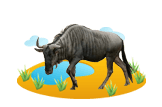
Wildebeest information and facts:
Scientific Name: Connochaetes taurinus
Type: Mammal
Diet: Herbivore
Average lifespan in the wild: 20 years
Size: Up to 4.5 ft (1.4 m)
Weight: 330 to 550 lbs (150 to 250 kg )
Group name: Herd
- For even more information also see the gnu.
-
Wildebeest video.
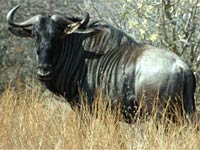
What does a wildebeest look like?
Several races of wildebeest (also called gnu) exist. The species that forms the large herds of the Serengeti-Mara ecosystem of Tanzania and Kenya is known as the western white-bearded wildebeest. The brindled or blue race occurs south of the Zambezi River; the eastern white-bearded race inhabits Kenya and Tanzania east of Gregory Rift.
The head of the wildebeest is large and box-like and both males and females have curving horns. The front end of the body is heavily built, the hindquarters slender and the legs spindly. The coat is gray and has a black mane and a beard which may be black or white.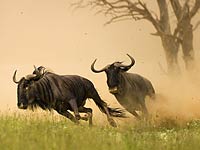
Where do wildebeests live?
Wildebeest occupy the plains and acacia savannas of eastern Africa. The largest mammal migration in the world is that of the Serengeti wildebeest. Huge scores of these antelopes congregate on the East African savannas, a sight which few who have seen will forget.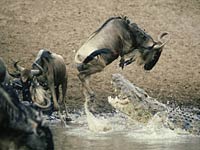
What does a wildebeest eat?
The wildebeest’s blunt muzzle and wide row of incisors are adapted for large bites of short grasses. Wildebeests are water dependant and grazing, trampling and manuring the grasses on which they feed stimulates new growth as long as the ground has sufficient moisture.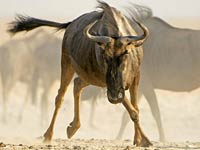
Did You Know this about the wildebeest?
- All wildebeest populations across Africa have declined except for the Serengeti population.
- Wildebeest are noisy creatures. Bulls have an array of loud vocalizations, from moans to explosive snorts.
- The northward journey of Africa's 1.5 million wildebeests, usually occurring in May or June, is the largest mammal migration in the world.
- There are two wildebeest species: the blue and the less commonly known black wildebeest. The latter has been essentially exterminated in the wild; today's relatively small herds are derived from captive specimens and exist only on game farms and in zoos.
- The blue wildebeest has a silvery blue sheen to its short-haired hide (the black wildebeest has a relatively plain hide).
Wildebeest images




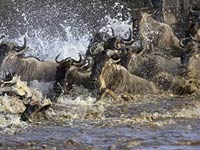
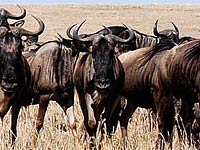
-

-
Wildebeest Wallpapers
Download free Wildebeest wallpapers, click on the image to open the large version. 
Wildebeest wallpaper 1
Wildebeest wallpaper 2
Wildebeest wallpaper 3
Wildebeest wallpaper 4
Wildebeest wallpaper 5
Wildebeest wallpaper 6
-
Wildebeest Coloring pages
Print free Wildebeest coloring pages, click on the image to open the large version. 
Wildebeest coloring page 1
Wildebeest coloring page 2




